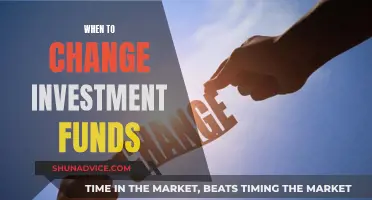
Index funds are a popular investment choice due to their low costs, low fuss, and diversification benefits. They are a type of mutual fund or exchange-traded fund (ETF) that aims to replicate the performance of a specific market index, such as the S&P 500. By investing in an index fund, individuals can gain exposure to a broad range of stocks or bonds with a single investment, often at a lower cost compared to actively managed funds.
Fidelity, a well-known investment firm, offers a wide range of index funds for its clients. When considering how to invest in an index fund with Fidelity, it is important to follow these steps:
1. Decide on your investment goals: Understand your investment objectives, risk tolerance, and time horizon. This will help you determine the type of index fund that aligns with your goals, such as retirement planning, saving for education, or investing for growth.
2. Research index funds offered by Fidelity: Explore the different index funds available through Fidelity, including broad market funds, sector funds, domestic funds, international funds, bond funds, and more. Evaluate the fund's objectives, performance, and expense ratios to find the best fit for your needs.
3. Choose the right index fund for your goals: Select the index fund that matches your investment goals and risk profile. Consider the return characteristics and volatility of the index the fund is tracking.
4. Open an account with Fidelity: To invest in Fidelity's index funds, you will need to open an investment account with them. You can choose between a retirement account, such as an Individual Retirement Account (IRA), or a non-retirement account, such as a regular brokerage account.
5. Fund your account: Transfer cash into your Fidelity investment account to start investing in the index funds you have selected.
6. Purchase shares of the chosen index fund: Use the money in your investment account to buy shares in the desired index fund(s). You can do this through Fidelity's website or app, depending on your preference.
7. Monitor your investments: It is important to periodically check on the performance of your index funds to ensure they are meeting your expectations. Regularly review your portfolio to make necessary adjustments and stay aligned with your investment goals.
By following these steps, individuals can invest in index funds through Fidelity, taking advantage of the benefits of index funds while utilizing the services of a reputable investment firm.
| Characteristics | Values |
|---|---|
| Investment goals | Long-term growth, income generation, or capital preservation |
| Investment approach | Passive investing, mirroring the performance of an index (e.g. S&P 500) |
| Investment provider | Fidelity, a renowned and trusted institution |
| Investment costs | Lower expense ratios compared to actively managed funds |
| Investment performance | Historically, the S&P 500 has an average return of over 10% per year since 1957 |
| Investment risk | Reduced risk through diversification, but still subject to market volatility |
| Investment taxes | Lower investment taxes due to less frequent selling |
| Investment control | Limited control over individual investments in the fund |
| Investment account | Requires opening an investment/brokerage account with Fidelity |
| Investment funding | Fund the account through bank transfers or electronic funds transfers |
| Investment order | Place an order through Fidelity's platform, specifying amount and instructions |
| Investment research | Compare funds based on expense ratios, performance history, fund size, and diversification |
What You'll Learn

Define your investment goals
Before investing in Fidelity index funds, it is crucial to define your investment goals clearly. These goals may include long-term growth, income generation, or capital preservation. Setting clear investment objectives is like charting a financial roadmap to help you navigate the unpredictable nature of the market. Each goal – whether it be growth for long-term wealth accumulation, income for steady cash flow, or preservation to safeguard your principal – requires a tailored strategy.
When considering Fidelity index funds, aligning your goals with the fund's investment approach can enhance portfolio performance. For instance, if your goal is long-term growth, you may benefit from investing in index funds that track high-growth sectors. On the other hand, if you are focused on income generation, you may want to look for funds with dividend-yielding securities.
Fidelity offers a wide range of index funds that cater to different investment goals. You can find funds that seek to track the performance of various stock market indexes, such as the S&P 500, or specific sectors like healthcare, technology, or consumer goods. They also offer international equity index funds and bond index funds. If you prefer a more diversified portfolio, Fidelity provides a combination of stock and bond index funds.
It is important to note that investing involves risk, and the value of your investments may fluctuate over time. Therefore, when defining your investment goals, you should carefully consider your risk tolerance, investment horizon, and financial situation. This will help you choose the most suitable Fidelity index fund that aligns with your goals and comfort level.
By clearly defining your investment goals and choosing the right Fidelity index funds, you can enhance your portfolio's performance and increase the likelihood of achieving your financial objectives.
Index Funds: Best Time to Invest and Maximize Returns
You may want to see also

Research different funds
Before investing in a particular index fund, it is crucial to conduct thorough research on the various funds available. This involves analysing several factors, including the fund's strategy, holdings, performance history, expense ratio, and tracking error. Here are some key considerations:
- Strategy and Holdings: Understand the investment strategies employed by different index funds and the types of assets they hold. This will give you insights into the level of risk and diversification offered by each fund.
- Performance History: Evaluate the historical performance of the funds to assess their consistency, volatility, and ability to achieve returns. Compare their performance with that of the underlying index they track.
- Expense Ratio: The expense ratio represents the annual fees charged by the fund, impacting your overall investment returns. Look for funds with lower expense ratios, as they can result in higher long-term returns.
- Tracking Error: This refers to the deviation between the fund's performance and that of its target index. Aim for funds with relatively stable and low tracking errors over time.
- Diversification: Opt for funds that provide diversification across various securities and sectors to reduce investment risk and enhance portfolio stability.
- Fund Size: Larger funds often offer improved liquidity and cost efficiency, better replicating the performance of the underlying index.
Fidelity offers a wide range of index funds, including:
- Broad Market Funds: These funds invest across companies of all sizes and industries, aiming to represent the stock market as a whole.
- Sector Funds: These focus on specific sectors such as healthcare, technology, or consumer goods.
- Domestic Funds: They track the performance of investment groups within the US.
- International Funds: These funds invest in markets outside the US.
- Bond Funds: They invest in bonds that comprise bond indexes.
- Dividend Funds: These funds focus on companies that pay out higher dividends.
- Sustainable and Socially Responsible Funds: These funds track market indexes while considering social and environmental factors.
When researching different funds, utilise tools like the Fidelity fund screener to compare expense ratios and other relevant metrics. Additionally, consider your investment goals and risk tolerance to make an informed decision.
Roth IRA vs. Mutual Funds: Why Choose the Former?
You may want to see also

Choose the right fund
When it comes to choosing the right Fidelity index fund, there are several factors to consider. Here are some guidelines to help you make an informed decision:
- Risk tolerance and investment horizon: Evaluate your risk tolerance and investment goals. Consider whether you are comfortable with market risks and how long you plan to invest for. This will help you determine the level of risk you are willing to take.
- Fund objectives: Different funds have different objectives. Some focus on broad market indices, while others target specific sectors or international markets. Choose funds that align with your investment strategy and preferences.
- Expense ratio: The expense ratio represents the annual fees charged by the fund. Lower expense ratios mean higher returns over time, as more of your investment gains remain in your pocket. Compare the expense ratios of different funds to find the most cost-effective option.
- Historical performance: Review the fund's historical performance data to assess its stability and potential for growth. Understanding how the fund has performed in various market conditions can help you gauge its ability to deliver returns.
- Tracking error: This refers to the difference between the fund's performance and that of the index it tracks. A lower tracking error indicates that the fund closely mirrors the index's performance.
- Diversification: Diversification helps reduce investment risk by spreading your assets across various securities and sectors. Look for funds with diversified holdings that align with your desired level of market exposure.
- Fund size: Larger funds tend to have improved liquidity, as higher assets under management can increase trading volume and reduce bid-ask spreads. However, also consider the impact of fund size on management fees and overall expenses.
- Tax efficiency: Consider the tax implications of investing in index funds. While index funds tend to have lower investment taxes due to less frequent trading, capital gains distributions and fund turnover can impact your after-tax returns.
- Sustainability: If you have specific social or ethical standards, consider Fidelity's sustainable index funds, which exclude companies that don't meet certain sustainability criteria.
- Sector focus: Depending on your investment strategy, you may want to focus on specific sectors. Fidelity offers sector-specific funds, such as health care, technology, consumer goods, or sustainable energy.
- Performance and growth: Review the fund's performance history and growth potential. Compare different metrics such as annualised returns, standard deviation, Sharpe ratio, and maximum drawdown to assess the fund's risk-adjusted returns and ability to outperform the market.
Remember, choosing the right Fidelity index fund depends on your individual financial goals, risk tolerance, and investment horizon. Conduct thorough research, compare different funds, and consider seeking professional advice to make informed investment decisions.
Funding Your Investment Property: Strategies for Success
You may want to see also

Open a brokerage account
To open a brokerage account, you need to decide on a broker. You should consider the number of index funds they offer, their fees, and how user-friendly their platform is.
Fidelity, for example, offers a wide range of index funds, including those that track the S&P 500, the Nasdaq Composite Index, and the Bloomberg Barclays Indices. They also offer sustainable index funds and have been named the Best Online Broker by Barron's multiple times.
Once you've chosen a broker, you can initiate the account opening process, which typically involves filling out an online application with your personal information and investment preferences. You may be required to provide proof of identification and address for verification. After submitting your application, your broker will process it, and you can then fund your account and start investing.
It's important to note that different brokers may have different requirements and steps for opening an account, so be sure to review their specific instructions carefully.
Singapore's Sovereign Wealth: Where Does the City-State Invest?
You may want to see also

Fund your account
After opening your account, it's time to fund it with the desired amount. This will allow you to start investing in Fidelity index funds. Make sure you meet the minimum investment requirements.
You have two options to fund your Fidelity account:
- Transfer money from your linked bank account through electronic funds transfer.
- Set up automatic contributions for a hassle-free investing experience.
It's important to note that the minimum investment thresholds vary for each Fidelity index fund, so check the requirements beforehand. When transferring funds, ensure you provide the correct account details to avoid any delays or complications.
Tips for a smooth process
- Double-check the account details: Before initiating the transfer, carefully review the account details to ensure you are sending the funds to the correct account.
- Allow for processing time: Keep in mind that electronic transfers may take a few business days to process. Plan your investments accordingly, especially if you have a specific purchase in mind.
- Set up automatic contributions carefully: If you choose to set up automatic contributions, ensure that you have sufficient funds in your linked bank account to avoid any issues with payments.
- Consider using a linked bank account: Using a linked bank account can streamline the process and make it easier to manage your investments.
- Seek customer support: If you have any questions or concerns during the funding process, don't hesitate to reach out to Fidelity's customer support team for assistance.
Smart Mutual Fund Investments with 10 Lakhs
You may want to see also
Frequently asked questions
Fidelity index funds are investment funds that aim to replicate the performance of a chosen market index, such as the S&P 500. By investing in the same securities as the index, these funds provide investors with a low-cost, diversified portfolio.
Investing in Fidelity index funds offers several advantages. Firstly, they provide diversified exposure to the market, reducing the risk associated with individual stocks. Secondly, they are managed by Fidelity, a trusted investment provider, ensuring expert management. Lastly, these funds have lower expense ratios compared to actively managed funds, resulting in higher returns for investors over time.
The first step is to determine your investment goals, such as long-term growth, income generation, or capital preservation. Next, research different Fidelity index funds to understand their strategies, holdings, and performance history. Once you've selected the fund that aligns with your goals and risk tolerance, open a brokerage account with Fidelity and fund it through methods like bank transfers. Finally, place an order for the chosen Fidelity index fund.
Fidelity offers a wide range of index funds, including those that track U.S. stock market indexes, international equity indexes, and bond indexes. They also provide sector-specific funds, such as healthcare, technology, and consumer goods. Additionally, Fidelity offers sustainable index funds that focus on socially responsible investing.
When choosing a Fidelity Index Fund, consider factors such as risk tolerance, investment horizon, and fund objectives. Evaluate the fund's expense ratio, historical performance, and tracking error. Diversification and the underlying assets of the fund should align with your desired level of market exposure. Compare different funds to find the one that best suits your financial objectives and risk profile.







